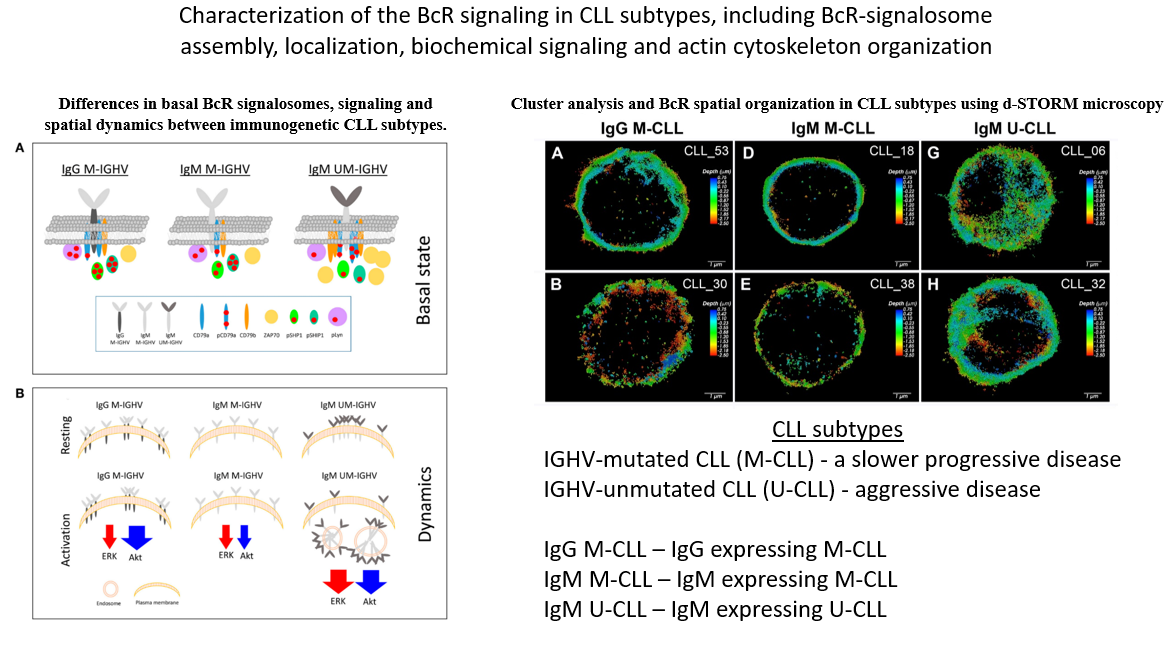Hematology Research Laboratory for CLL
R&D > Laboratories > Hematology Research Laboratory for CLL-Prof. Yair Herishanu & Dr. Ben-Zion Katz

Our Vision
Chronic lymphocytic leukemia (CLL) is the most common type of leukemia among adults in the western world. Despite advances in chemotherapy, immunotherapy, and targeted therapies, none of these treatments is curative and resistance emerges over time. Therefore, there is a need for new therapeutic approaches for CLL.B cell receptor (BcR) signaling has a critical role in the pathogenesis of CLL. This is amply attested by the distinct outcomes of patients with different configuration of the clonotypic BcR immunoglobulin. Our research aims to characterize the BcR signaling in CLL subtypes, including BcR-signalosome assembly, localization, biochemical signaling and actin cytoskeleton organization. In addition, our lab focuses on evaluating the therapeutic potential of novel agents such as proteolysis targeting chimeras (PROTACs) and bi-specific antibodies combined with established CLL treatments to enhance cellular therapies. The advantage of our research is the use of patient-derived CLL samples and the direct access to medical data that enable the connection between basic science and the clinic. Insights gained from this research could pave the way for the design of more targeted and personalized therapeutic strategies in CLL management, fostering advancements in precision medicine approaches for hematological malignancies.

Contact Us
Primary Investigators

Prof. Yair Herishanu, Lab PI

Dr. Ben-Zion Katz , Lab PI
benzik@tlvmc.gov.il

Dr. Yamit Shorer Arbel , Lab manager
General Contact
Address
Sammy Ofer Heart Building
10th floor Room 92

Research
In our study, we demonstrated fundamental differences in the early BcR signalosome, biochemical status and spatial organization between CLL immunogenetic subtypes. BcR clustering is crucial for the activation of the BcR signaling pathway. Our findings reveal distinct sub-cellular distribution patterns according to the IGHV gene somatic hypermutation (SHM) status and immunoglobulin subclass usage. In particular, we showed that the IgG class-switched M-CLL is biologically closely related to IgM M-CLL and has a similar favorable clinical outcome.
PROTAC, a novel strategy that utilizes the intracellular ubiquitin-proteasome system to induce targeted protein degradation, is receiving much attention in the field of targeted therapies. In collaboration with Prof. Nir London’s group from the Weizmann Institute of Science, we demonstrated the effect of several ibrutinib-based BTK PROTACs on CLL cells, including cell resistance to current therapeutics. PROTACs present a very promising and powerful approach for the development of targeted therapy drugs and may be a future optional therapy for CLL, especially for ibrutinib resistant patients. More efforts are undergoing to get deeper insight into the efficacy and safety of PROTACs in the clinic.
Bi-specific antibodies are designed to engage T cells and B cells simultaneously, conveying the patient’s T-cells into proximity to their B-cells and facilitating the immune system’s ability to target and eliminate cancer cells. While bi-specific antibodies have shown impressive efficacy in aggressive and indolent lymphomas, preliminary studies in CLL have reported rather disappointing results due to the immunosuppression that accompanies the disease. Our research focuses on elucidating mechanisms underlining the poor performance of cellular therapies in CLL, thereby exploring possibilities to enhance their anti-tumor activity.
Gallery

Our Team
Current Staff
Researchers
- Prof. Yair Herishanu, MD
- Dr. Ben-Zion Katz, PhD
- Dr. Yamit Shorer Arbel, PhD
- Liron Yitzhak, MSc
Past Staff
Current funding

Highlight Publications
Spatial organization and early signaling of the B-cell receptor in CLL
Shorer Arbel Y, Bronstein Y, Dadosh T, Kamdjou T, Tsuriel S, Shapiro M, Katz BZ, Herishanu Y. Front Immunol. 2022 Aug 9;13:953660. |
Shorer Arbel Y, Katz BZ, Gabizon R, Shraga A, Bronstein Y, Kamdjou T, Globerson Levin A, Perry C, Avivi I, London N, Herishanu Y. Front Oncol. 2021 May 13;11:646971. |
Efficient Targeted Degradation via Reversible and Irreversible Covalent PROTACs Gabizon R, Shraga A, Gehrtz P, Livnah E, Shorer Y, Gurwicz N, Avram L, Unger T, Aharoni H, Albeck S, Brandis A, Shulman Z, Katz BZ, Herishanu Y, London N. J Am Chem Soc. 2020 Jul 8;142(27):11734-11742. |
More Publications >>
Sulfamate Acetamides as Self-Immolative Electrophiles for Covalent Ligand-Directed Release Chemistry Reddi RN, Rogel A, Gabizon R, Rawale DG, Harish B, Marom S, Tivon B, Arbel YS, Gurwicz N, Oren R, David K, Liu J, Duberstein S, Itkin M, Malitsky S, Barr H, Katz BZ, Herishanu Y, Shachar I, Shulman Z, London N.. J Am Chem Soc. 2023 Feb 15;145(6):3346-3360. |
Efficacy of the BNT162b2 mRNA COVID-19 vaccine in patients with chronic lymphocytic leukemia Herishanu Y, Avivi I, Aharon A, Shefer G, Levi S, Bronstein Y, Morales M, Ziv T, Shorer Arbel Y, Scarfò L, Joffe E, Perry C, Ghia P. Blood. 2021 Jun 10;137(23):3165-3173 |
CLL and COVID-19: light at the end of the tunnel? Scarfò L, Herishanu Y. Blood. 2022 Aug 4;140(5):407-409. |







